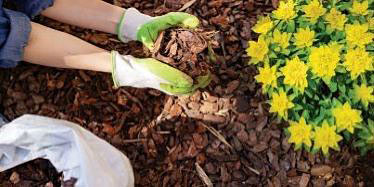Waterwise gardening
Mulching

Mulching is an essential element of a water-efficient garden. Mulching around plants saves water by reducing evaporation and run-off. Depending on the type of mulch, it limits weed growth and can improve soil conditions by adding nutrients. Mulching also protects plant roots from high temperatures and soil from erosion.
Choose the right mulch
There are many different types of mulch to choose from.
Organic mulch, such as sugar cane, grass clippings, leaves or pine bark, breaks down over time and improves your soil. Organic mulch needs to be topped up frequently, preferably in autumn and spring.
Coarse organic mulch, which allows water to infiltrate more easily, is good for reducing weeds and keeping soil cool, but it will not improve the soil’s texture as the mulch does not readily break down.
Organic mulch made of fine particles (such as grass clippings) can improve the soil’s texture as it breaks down more easily; however, it is more prone to compaction so will need to be loosened regularly to ensure water penetration.
Inorganic mulch, such as rocks and pebbles, helps to reduce evaporation but doesn’t improve the soil.
Prepare for success
For the best result, prepare the soil by removing weeds, raking or digging the surface and watering the remaining plants. Place a layer of newspaper over the soil to deter weed growth, but make sure it’s not too thick as it will reduce air supply to the soil.
Spread the mulch layer
The ideal thickness of the mulch layer depends on the particle size of the mulch material. If using large chunks, such as pine bark, a deeper layer (more than 5 cm) is needed. Mulch made of fine particles is more prone to compaction so it should be applied in a thinner layer of around 2 cm.
Be sure to keep the mulch about 6-7cm clear of plant stems or they may rot.
Watch for nitrogen deficiency
As organic mulch decomposes it can draw nitrogen from the soil. Watch your plants for signs of nitrogen deficiency (usually indicated by yellowing of the lower leaves) and use a nitrogen-rich fertiliser if needed.
In this guide:


